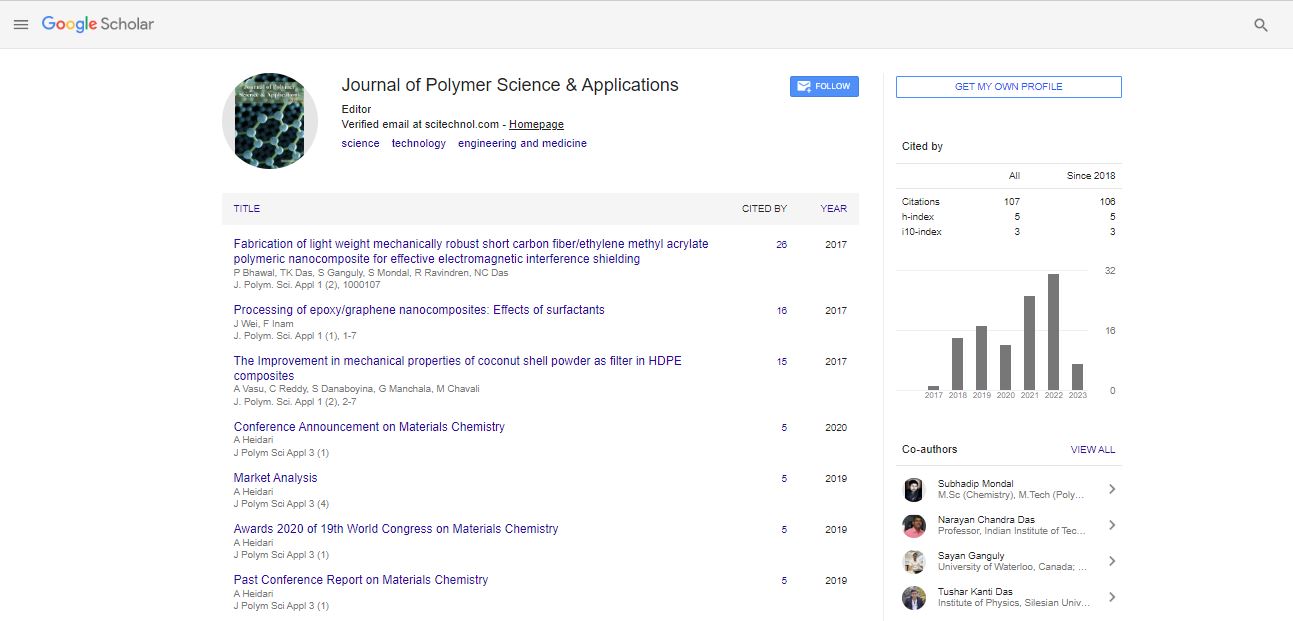Perspective, J Polym Sci Appl Vol: 7 Issue: 4
RAFT Polymerizations Role in Advanced Material Development
Satu Perrier*
1Department of Chemistry, University of WarwickCoventry, Coventry, UK
*Corresponding Author: Satu Perrier,
Department of Chemistry, University of
WarwickCoventry CV4 7AL UK
E-mail: perriersatu@gmail.com
Received date: 20 November, 2023 Manuscript No. JPSA-24-123863;
Editor assigned date: 22 November, 2023, PreQC No. JPSA-24-123863 (PQ);
Reviewed date: 06 December, 2023, QC No. JPSA-24-123863;
Revised date: 13 December, 2023, Manuscript No. JPSA-24-123863 (R);
Published date: 20 December, 2023, DOI: 10.4172/Jpsa.1000146
Citation: Perrier S (2023) Exploring Reversible Addition-Fragmentation Chain Transfer (RAFT) Polymerization. J Polym Sci Appl 7:4.
Description
Polymerization is a fundamental process in the field of chemistry that involves the creation of long-chain molecules, known as polymers, from smaller monomer units. Among the various polymerization techniques, Reversible Addition-Fragmentation Chain Transfer (RAFT) polymerization has emerged as a versatile and powerful method for the controlled synthesis of polymers with specific properties. RAFT polymerization allows for precise control over the molecular weight, architecture, and functionality of polymers, making it a widely used technique in both academic research and industrial applications.
RAFT polymerization is a type of controlled radical polymerization that enables the synthesis of polymers with well-defined structures. The key feature of RAFT is its ability to control the polymerization process by reversible chain transfer reactions. In conventional radical polymerization, the reaction proceeds uncontrollably, leading to polymers with broad molecular weight distributions. RAFT polymerization overcomes this limitation by using a Chain Transfer Agent (CTA) that regulates the polymerization and maintains control over the polymer chain growth.
Mechanism of RAFT polymerization
The mechanism of RAFT polymerization involves three main steps: initiation, propagation, and termination. The chain transfer agent plays a crucial role in the propagation step, allowing for the reversible addition-fragmentation of polymer chains. The CTA contains a thiocarbonylthio group that facilitates the transfer of the growing polymer chain between the monomer and the CTA, regulating the polymerization process. The reversible nature of the chain transfer reaction distinguishes RAFT polymerization from traditional radical polymerization methods.
One of the key advantages of RAFT polymerization is its ability to achieve controlled molecular weight of the resulting polymers. Traditional radical polymerization often results in polymers with a wide range of molecular weights due to the uncontrollable nature of the process. In RAFT polymerization, the CTA regulates the chain length by mediating the transfer of the polymer chain, leading to polymers with a narrow molecular weight distribution. This control is crucial for applications where consistent and predictable polymer properties are essential.
RAFT polymerization offers versatility in designing polymers with specific architectures. Researchers can tailor the polymer structure by adjusting the reaction conditions and the choice of monomers. This flexibility allows for the synthesis of block copolymers, graft copolymers, and other complex architectures with precise control over composition and sequence. The ability to create well-defined polymer structures is particularly valuable in the development of advanced materials, drug delivery systems, and functional coatings.
RAFT polymerization exhibits remarkable tolerance towards various functional groups, making it compatible with a wide range of monomers. This feature enables the incorporation of diverse functionalities into the polymer backbone, expanding the applications of RAFT-synthesized polymers. Functional group tolerance is especially beneficial when designing polymers for specific applications such as biomaterials, where the presence of functional groups is critical for interactions with biological systems.
Applications of RAFT polymerization
The controlled nature of RAFT polymerization has led to its widespread use in various applications. One notable area is the development of smart materials and responsive polymers. By carefully designing the polymer structure using RAFT, researchers can create stimuli-responsive materials that undergo changes in response to external stimuli such as temperature, pH, or light. These materials find applications in drug delivery, sensors, and other fields where controlled responses are essential.
In the pharmaceutical industry, RAFT polymerization has been employed to design polymer-drug conjugates with controlled release profiles. The ability to precisely control the molecular weight and structure of the polymer allows for the customization of drug delivery systems, optimizing therapeutic efficacy and minimizing side effects.
Reversible Addition-Fragmentation Chain Transfer (RAFT) polymerization has emerged as a powerful tool in the field of polymer chemistry, offering unprecedented control over the synthesis of polymers. The ability to regulate molecular weight, control polymer architecture, and tolerate various functional groups makes RAFT polymerization a versatile technique with broad applications. As research in polymer science continues to advance, RAFT polymerization is expected to play a pivotal role in the development of innovative materials with tailored properties for a wide range of applications.
 Spanish
Spanish  Chinese
Chinese  Russian
Russian  German
German  French
French  Japanese
Japanese  Portuguese
Portuguese  Hindi
Hindi 